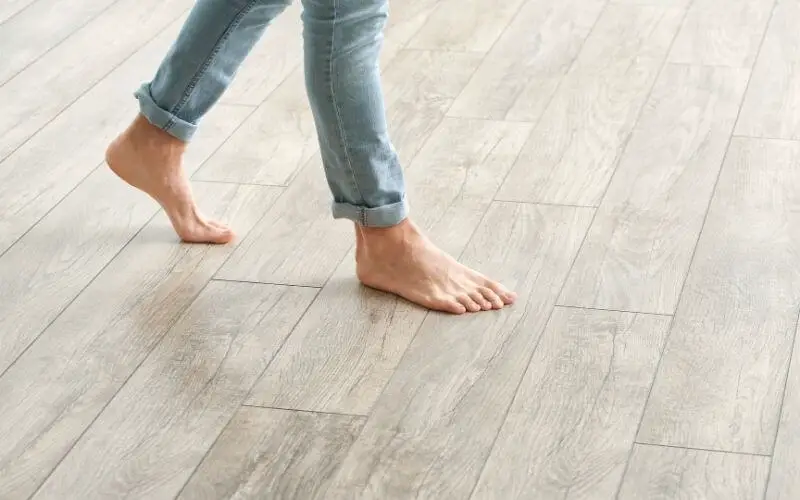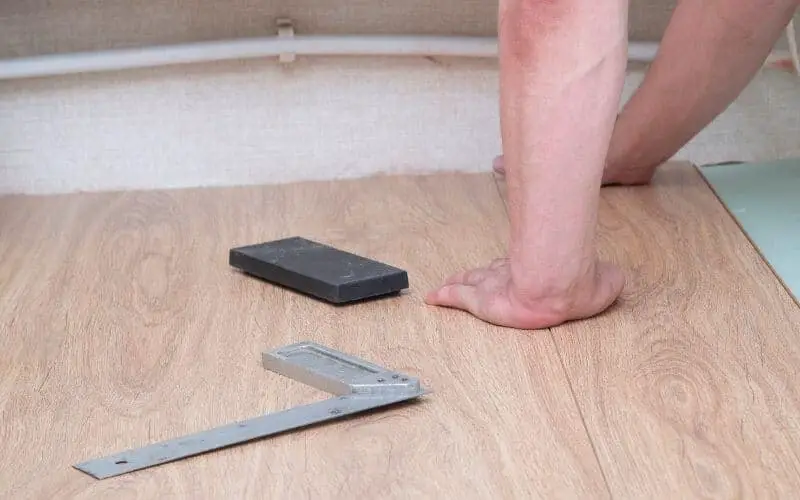One of the issues associated with laminate floors is the issue of bouncing. And this tends to discourage laminate users a great deal. It gives off this cringy and uncomfortable feeling in the home.
This post will reveal the reasons your laminate flooring feels bouncy. These are caused by; Water damage, Damaged floor joist, structural issues when the trusses are far apart, and finally, when not properly acclimated.
Read on as we show you the reasons for this in detail.
Reasons your Laminate Flooring Feels Bouncy
Table of Contents
Finding out why one’s floor is bouncy helps trace the problem to the root. A bouncy floor can be caused by one or more factors combined. Let us go through these factors.
1. Water Damage
Water leaking out from damaged pipes or the roof can cause damages to the subfloor. Laminate floors are made from planks that aren’t waterproof; hence, they become bouncy from continuous exposure to liquids.
Related: How to fix laminate flooring water damage
2. Damaged Floor Joist
In a case where termites make their way into the house, they feed on the wood found on the subfloor joist. And this weakens the layout and base of this subfloor joist by causing cracks and damages.
Placing heavy objects or loads also affects the subfloor joist; thereby making the laminate floor bouncy.
3. Structural Issues
The building follows a regular pattern. The roof, foundation, and flooring are meant to reach a particular criterion. If an engineer makes a mistake during this process, it leaves the floor bouncy and saggy as it progresses.
This is usually rare in a new house, but you might have this issue when renovating the house.
4. When the Trusses are Far Apart
In a case where a truss cannot shoulder a heavyweight, it tends to become bouncy or saggy over time. Woods tends to bend when the weight is much, so engineers are advised to calculate the safe weight.
If the trusses are placed closer to each other, they can easily carry the weight without fear of bouncing.
5. When not Properly Acclimated
During installation, be sure that the laminate floor had fully adapted to the room’s temperature and humidity. If the floor does not acclimate properly, it might make the floor expand and contract at some point. Thereby leading to a bouncy floor.
Read: Does laminate floor need to acclimate
How to Fix Bouncy Laminate Floors
One of the issues faced by most laminate owners is the problem of a bouncy floor. Though this might not be seen as extremely serious, it can be very unpleasant.
Here are a few tips on how to fix bouncy laminate floors.
1. Addressing the Moisture Problems
One of the reasons for bouncy floors is moisture issues. Try fixing the problems of leaking roofs or pipes. Do your best to get them fixed because failure to do so would cause more damage to the laminate floor.
Also, look out for water spillage, and don’t use a too-wet mop to wipe the floor. Regulate the temperature and humidity level with devices to prevent the floor from being bouncy.
2. By Adding a Bridge
Adding bridges to the laminate floor would make the planks under the floor share the weight on the floor surface. Look out for the initial bridging to ensure that none of them have loosened. Repair the loose bridge if there is any.
If it still doesn’t work, place a row on the flank of the existing bridge to harden the floor. You can also install the bridge in the range’s center.
3. Installing a Layer of Plywood
Add an extra layer of plywood to the joist to harden the floor and minimize side-to-side bending. Because if the plank bends, the lower part ends up leaning to one end, which isn’t right.
Attach the plank to the subfloor for it to work effectively. If the laminate floor squeaks, then the plank and the subfloor are not well fastened.
Apply adhesive and sand the underside of the plank for the adhesive to stick firmly.
4. Install a Beam or Wall
It is also recommended to install a beam or wall, as planks that last long experience more deflection. Place a wall underneath the joist to separate the range; this would make the floor above the joist firmer.
You can also install a beam if using a wall doesn’t suffice. But it involves more work than when using the wall.
5. Replacing Boards
Some causes of a bouncy floor result from the board itself. If the laminate floor is already bouncy due to intense moisture damage, it is best to replace it.
Ensure to trim them if placed beside the wall to give them room for extension.
Related: How difficult is it to replace floor joist
How to Prevent Laminate Floor from Bouncing
Suppose you are set to install a laminate in your new home and worried about it bouncing over time. Here are are few tips to prevent such.
1. Let the Laminate Floor Acclimate
Give the laminate floor a few days to adapt to the temperature and humidity level before moving into the house. This would help limit the tendency of the floor shrinking or expanding.
Read: Does laminate floor need to settle?
2. Seek the Help of a Floor Contractor
If you find out an issue with a substrate level floor, you should call on a flooring contractor to fix the issue.
3. Do not use Cheap Underlayment
It is best to use high-quality underlayment to prevent the laminate floor from being too bouncy.
Conclusion
What are the reasons your laminate flooring feels bouncy? A bouncy laminate floor can be caused by a variety of issues such as water damage, damaged joist, and lack of acclimation. However, If the guidelines above on how to fix bouncy laminate floors are followed, this can be solved easily.

